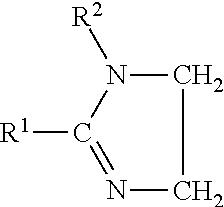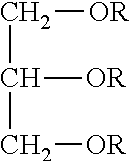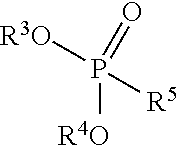Friction modifiers for slideway applications
a technology of friction modifiers and additives, applied in the field of additive formulations used in slideway applications, can solve the problems that lubricant additives that are effective for metal surfaces may not be effective in reducing friction, and achieve the effect of improving friction-reducing properties and similar friction-reducing properties
- Summary
- Abstract
- Description
- Claims
- Application Information
AI Technical Summary
Benefits of technology
Problems solved by technology
Method used
Image
Examples
example 1
[0040]Boundary friction coefficients were measured using a PCS Instruments High Frequency Reciprocating Rig (HFRR). Friction coefficients were measured at 130° C. between a SAE 52100 metal ball and either a SAE 52100 metal disk or a 1 cm by 1 cm piece of plastic slideway material. The ball was oscillated across the materials at a frequency of 20 Hz over a 1 mm path, with an applied load of 4.0 N.
[0041]All fluids in Table I were blended into a Group II base oil with a 100° C. kinematic viscosity of ˜4.0 cSt. The friction modifiers, anti-wear / extreme pressure agents and detergents were added to the base oil at a concentration of 0.40 weight percent. The dispersants were added to the base oil at a concentration of 3.0 weight percent.
[0042]Table I shows the friction data for a series of fluids containing 1) a friction modifier, 2) an anti-wear / extreme pressure agent 3) a detergent and 4) a dispersant. The friction modifiers used in these fluids include: a metal-free, amine-containing fr...
example 2
[0048]In another series of tests, boundary friction coefficients were measured as in Example 1 at 130° C. between a SAE 52100 metal ball and a 1 cm by 1 cm piece of plastic slideway material. In test fluid contained a base oil having only 0.2 weight percent of each of the friction modifiers or anti-wear agents listed in example 1. The results are given in the following Table 3.
[0049]
TABLE 3Weight percent130° C. Frictionin base oilAdditiveCoefficient on plastic0.20MoDTC0.2680.20ZDDP0.2020.20Thiadiazole0.1420.20GMO0.1060.20DMOP0.0940.20U-O0.072
[0050]According to the foregoing examples, the following observations may be articulated:[0051]1) metal-free friction modifiers (thiadiazole, GMO, DMOP and U-O) reduce friction on plastic better than metal-containing friction modifiers.[0052]2) amine-containing metal-free friction modifiers (U-O) reduce friction better than amine-free metal-free friction modifiers.[0053]3) metal- and sulfur-free phosphorus compounds (DMOP) reduce friction on pla...
PUM
| Property | Measurement | Unit |
|---|---|---|
| weight percent | aaaaa | aaaaa |
| weight percent | aaaaa | aaaaa |
| frequency | aaaaa | aaaaa |
Abstract
Description
Claims
Application Information
 Login to View More
Login to View More - R&D
- Intellectual Property
- Life Sciences
- Materials
- Tech Scout
- Unparalleled Data Quality
- Higher Quality Content
- 60% Fewer Hallucinations
Browse by: Latest US Patents, China's latest patents, Technical Efficacy Thesaurus, Application Domain, Technology Topic, Popular Technical Reports.
© 2025 PatSnap. All rights reserved.Legal|Privacy policy|Modern Slavery Act Transparency Statement|Sitemap|About US| Contact US: help@patsnap.com



